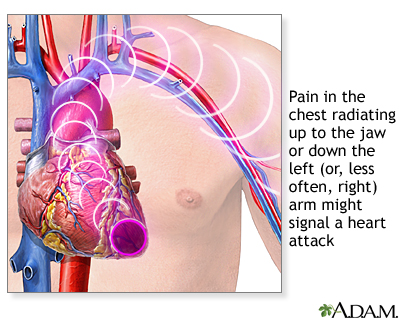Heart Attack
Acute MI

A heart attack or acute myocardial infarction (MI) occurs when one of the arteries that supplies the heart muscle becomes blocked. Blockage may be caused by spasm of the artery or by atherosclerosis with acute clot formation. The blockage results in damaged tissue and a permanent loss of contraction of this portion of the heart muscle.
Post myocardial infarction ECG wave tracings

Various phases can be seen through ECG wave tracings following a heart attack:
- Hyperacute phase begins immediately after a heart attack
- Fully evolved phase starts a few hours to days after a heart attack
- Resolution phase appears a few weeks after a heart attack
- Stabilized chronic phase is the last phase and typically has permanent pathological changes compared to a normal ECG tracing
Progressive build-up of plaque in coronary artery

Plaque may build-up in a coronary artery at the site of a tear in the lining of the vessel.
Posterior heart arteries

The coronary arteries supply blood to the heart muscle. The right coronary artery supplies both the left and the right heart; the left coronary artery supplies the left heart.
Anterior heart arteries

The coronary arteries supply blood to the heart muscle. The right coronary artery supplies both the left and the right heart; the left coronary artery supplies the left heart.
Heart attack symptoms

Symptoms of a possible heart attack include chest pain and pain that radiates down the shoulder and arm.
A heart attack is when low blood flow causes the heart to starve for oxygen. Heart muscle dies or becomes permanently damaged. Your doctor calls this a myocardial infarction.
Causes, incidence, and risk factors
Most heart attacks are caused by a blood clot that blocks one of the coronary arteries. The coronary arteries bring blood and oxygen to the heart. If the blood flow is blocked, the heart starves for oxygen and heart cells die. A clot most often forms in a coronary artery that has become narrow because of the build-up of a substance called plaque along the artery walls. (See: atherosclerosis) Sometimes, the plaque cracks and triggers a blood clot to form. Occasionally, sudden overwhelming stress can trigger a heart attack. It is difficult to estimate exactly how common heart attacks are because as many as 200,000 to 300,000 people in the United States die each year before medical help is sought. It is estimated that approximately 1 million patients visit the hospital each year with a heart attack. About 1 out of every 5 deaths are due to a heart attack. Risk factors for heart attack and coronary artery disease include: Higher-than-normal levels of homocysteine, C-reactive protein, and fibrinogen may also increase your risk for a heart attack. Homocysteine is an amino acid. C-reactive protein and fibrinogen are linked to inflammation. Fibrinogen is also involved in blood clotting.
Chest pain is a major symptom of heart attack. However, some people may have little or no chest pain, especially the elderly and those with diabetes. This is called a silent heart attack. The pain may be felt in only one part of the body or move from your chest to your arms, shoulder, neck, teeth, jaw, belly area, or back. The pain can be severe or mild. It can feel like: Pain usually lasts longer than 20 minutes. Rest and a medicine called nitroglycerine do not completely relieve the pain of a heart attack. Other symptoms of a heart attack include:
Signs and tests
A heart attack is a medical emergency. If you have symptoms of a heart attack, seek immediate medical help. The health care provider will perform a physical exam and listen to your chest using a stethoscope. The doctor may hear abnormal sounds in your lungs (called crackles), a heart murmur, or other abnormal sounds. You may have a rapid pulse. Blood pressure may be normal, high, or low. Tests to look at your heart include: Blood tests can help show if you have substances produced by heart tissue damage or a high risk for heart attack. These include:
Treatment
If you had a heart attack, you will need to stay in the hospital, possibly in the intensive care unit (ICU). You will be hooked up to an ECG machine, so the health care team can look at how your heart is beating. Life-threatening arrhythmias (irregular heart beats) are the leading cause of death in the first few hours of a heart attack. The health care team will give you oxygen, even if your blood oxygen levels are normal. This is done so that your body tissues have easy access to oxygen, so your heart doesn't have to work as hard. An intravenous line (IV) will be placed into one of your veins. Medicines and fluids pass through this IV. You may need a tube inserted into your bladder (urinary catheter) so that doctors can see how much fluid your body gets rid of. THROMBOLYTIC THERAPY Depending on the results of the ECG, certain patients may be given blood thinners within 12 hours of when they first felt the chest pain. This is called thrombolytic therapy. The medicine is first given through an IV. Blood thinners taken by mouth may be prescribed later to prevent clots from forming. Thrombolytic therapy is not appropriate for people who have: Thrombolytic therapy is extremely dangerous in women who are pregnant or persons who have: MEDICINES FOR HEART ATTACKS Many different medicines are used to treat and prevent heart attacks. Nitroglycein helps reduce chest pain. You may also receive strong medicines to relieve pain. Antiplatelet medicines help prevent clot formation. Aspirin is an antiplatelet drug. Another one is clopidogrel (Plavix). Beta-blockers (such as metoprolol, atenolol, and propranolol) help reduce the strain on the heart and lower blood pressure. ACE inhibitors (such as ramipril, lisinopril, enalapril, or captopril) are used to prevent heart failure and lower blood pressure.
No comments:
Post a Comment